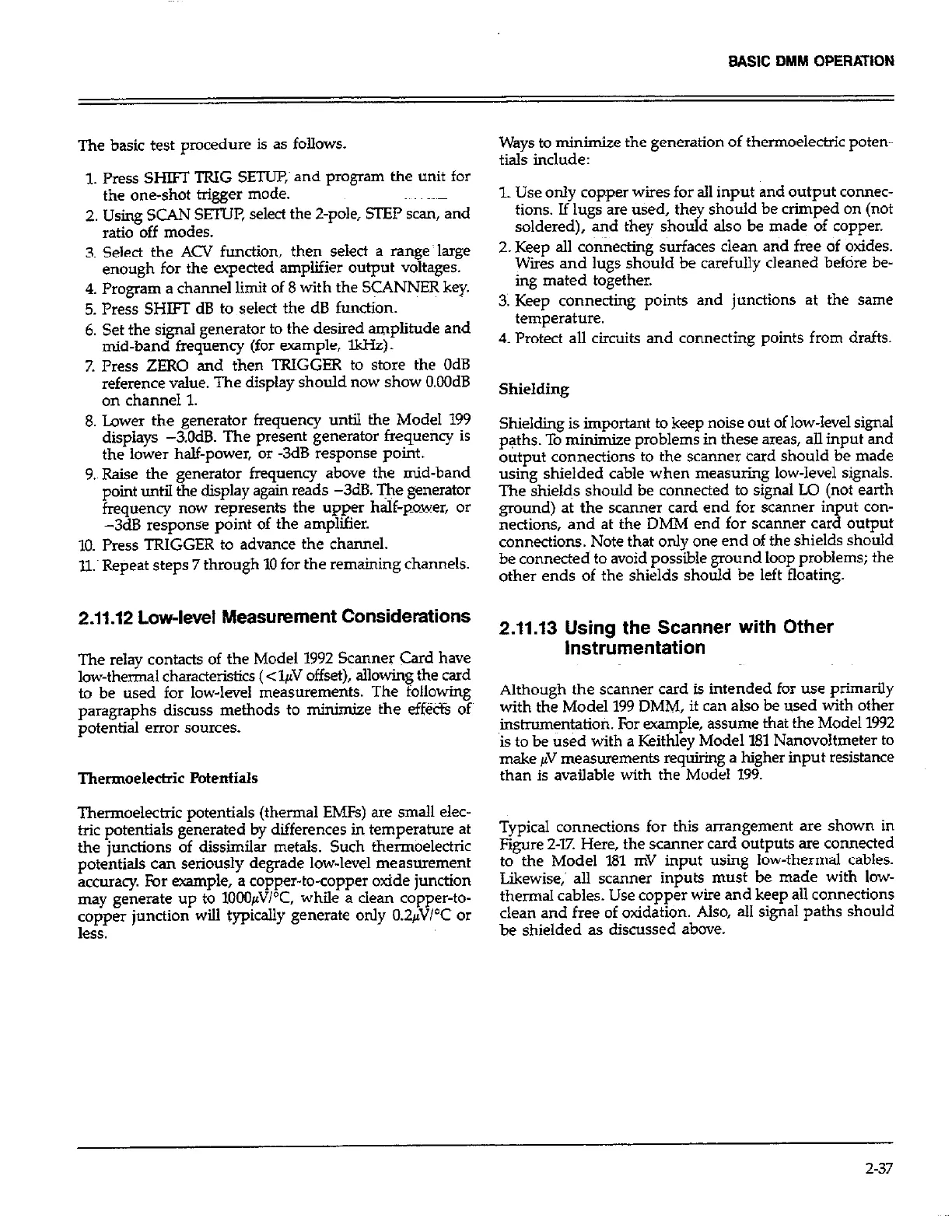BASIC DMM OPERATION
The basic test procedure is as follows.
1. Press SHIl!T TRIG SETW and program the unit for
the one-shot trigger mode.
2. Using SCAN SETUP, select the Z-pole, %I scan, and
ratio off modes.
3. Select the ACV function, then select a range~large
enough for the expected amplifier output voltages.
4. Program a channel limit of 8 with the SCANNER key.
5. Press SHIFT dB to select the dB function.
6. Set the signal generator to the desired amplitude and
mid-band frequency (for example, lkHz).
7. Press ZERO and then TRIGGER to store the OdB
reference value. The display should now show O.OOdB
on channel 1.
8. Lower the generator frequency until the Model 199
displays -3.OdB. The present generator frequency is
the lower half-power, or -3dB response point.
9. Raise the generator frequency above the mid-band
point until the display again reads -3dB. -l’Jxe generator
frequency now represents the upper half-power, or
-3dB response point of the amplifier.
10. Press TRIGGER to advance the channel.
11.~ Repeat steps 7 through 10 for the remaining channels.
2.11.12 Low-level Measurement Considerations
The relay contacts of the Model 1992 Scanner Card have
low-thermal characteristics (clr;V offset), allowing the card
to be used for low-level measurements. The following
paragraphs discuss methods to minimize the effe& oft
potential error sources.
Thermoelectric Potentials
Thermoelectric potentials (thermal EMFs) are small elec-
tric potentials generated by differences in temperature at
the junctions of dissimilar metals. Such thermoelectric
potentials can seriously degrade low-level measwement
accuracy. For example, a copper-to-cop~per oxide junction
may generate up to lOOO~WC, while a clean copper-to-
copper junction will typically generate only O&WC or
less.
Ways to minimize the generation of thermoelectric poten-
tials include:
L Use only copper wires for all input and output connec-
tions. If lugs are used, they should be crimped on (not
soldered), and they should also be made of copper.
2. Keep all connecting surfaces clean and free of oxides.
Wires and lugs should be carefully cleaned before be-
ing mated together.
3. Keep connecting points and junctions at the same
temperature.
4. Protect all circuits and connecting points from drafts.
Shielding
Shielding is important to keep noise out of low-level signal
p”hs. To m inimize problems in these areas, all input and
output connections to the scanner card should be made
using shielded cable when measuring low-level signals.
The shields should be connected to signal LQ (not earth
ground) at the scanner card end for scanner input con-
nections, and at the DMM end for scanner card output
connections. Note that only one end of the shields should
be connected to avoid possible ground loop problems; the
other ends of the shields should be left floating.
2.11.13 Using the Scanner with Other
Instrumentation
Although the scanner card is intended for use primarily
with the Model 199 DMM, it can also be wed with other
instrmnentatio”. For -pie, assume that the Model 1992
is to be used with a Keithley Model 181 Nanovoltmeter to
make PV measurements requiring a higher input resistance
than is available with the Model 199.
Typical connections for this arrangement are shown in
Figure 2-K’. Here, the scanner card outputs are connected
to the Model 181 mV input using low-thermal cables.
Likewise,’ all scanner inputs must be made with low-
thermal cables. Use copper wire and keep all connections
clean and free of oxidation. Also, all signal paths should
be shielded as discussed above.
2-37
